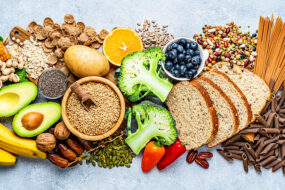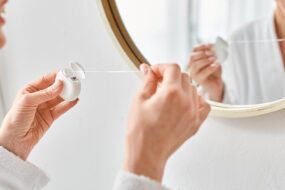Tired? Here’s how to support yourself when your dietary intake of iron is inadequate
Iron is an essential requirement for a healthy life and not enough can cause fatigue (among other things). However, it’s easy to support your levels by making sure you’re sourcing and absorbing enough.
Iron is an essential mineral for our bodies and is one of the essential requirements for a healthy life1.
It helps the body make haemoglobin2, a protein in red blood cells, which carry oxygen around the body.
It also supports nervous system function, stamina and energy production.
If you don’t have enough iron in your system, you may feel tired3.
Premenopausal women4 should monitor their iron levels closely, because of blood loss during menstruation, while women also need more iron during pregnancy5.
If you’re ever concerned about your iron levels, the first thing to do is contact your trusted healthcare professional.
Sourcing and absorbing iron
Our bodies can’t make iron, so we rely on outside sources.
There are two types of iron in food6. Haem iron is easily absorbed by the body, and is found in meat, fish and poultry. Non-heam iron, which is harder for our bodies to absorb, is found in things such as dark leafy vegetables.
A good way to include iron in your diet7 is by eating balanced meals with meat, legumes, leafy vegetables and fish.
But iron intake is only half the picture — iron absorption is also critical and this can vary widely.
Typically, a healthy body absorbs about 18 per cent8 of the iron available in an omnivore western diet.
However, vegetarians absorb only around 10 per cent9 of the non-haem iron available in their diets.
Other factors impact how your body absorbs iron.
For example, drinking tea, coffee or wine reduces iron absorption10.
Some health conditions11 can also affect your ability to absorb iron. If you have any concerns, it’s important to speak to your healthcare provider to ensure your iron levels are adequate.
Effective ways to support your iron levels
Your iron levels can be difficult to increase quickly12 through diet alone.
Iron supplements help support levels in the body, because they contain higher levels of iron than food.
A liquid iron supplement13 absorbs quickly, which is crucial to supporting your energy levels14.
Floradix Liquid Iron Plus and Floradix Floravital Liquid Iron Plus contain Ferrous gluconate, which is highly bioavailable. The less-constipation formulation is gentle on the stomach and digestive system.
Nutrients in Floradix Liquid Iron products are already dissolved, so they are absorbed more quickly by the digestive system than iron tablets.
The Floradix Liquid Iron range contains Vitamins B2, B3 and B6, and is formulated with herbal extracts and fruit juice concentrate so it tastes good.
Plus they are suitable for vegetarians and free from colourings, lactose, alcohol and egg.
If you want to relieve tiredness when dietary intake of iron is inadequate and want to support energy production, try Floradix Liquid Iron Plus or Floradix Floravital Liquid Iron Plus.
This post is brought to you by Floradix Floravital Liquid Iron Plus. Always read the label and follow the directions for use. Dietary supplements] should not replace a balanced diet. Not for the treatment of iron deficiency conditions. If symptoms persist see your healthcare professional.
1Piskin et al, 2022, Iron Absorption: Factors, Limitations, and Improvement Methods, ACS Omega 7:24, retrieved January 2024 from https://www.ncbi.nlm.nih.gov/pmc/articles/PMC9219084/
2Healthdirect, 2023, retrieved January 2024 from https://www.healthdirect.gov.au/iron-deficiency
3Patterson, A.J., Brown, W.J., Powers, J.R. et al. Qual Life Res 9, 491–497 (2000). Retrieved January 2024 from https://doi.org/10.1023/A:1008978114650
4Healthdirect, 2023, retrieved January 2024 from https://www.healthdirect.gov.au/iron-deficiency
5Better Health Channel, retrieved January 2024 from https://www.betterhealth.vic.gov.au/health/conditionsandtreatments/iron
6Healthdirect, 2023, Foods high in iron, retrieved January 2024 from https://www.healthdirect.gov.au/foods-high-in-iron
7Better Health Channel, retrieved January 2024 from https://www.betterhealth.vic.gov.au/health/conditionsandtreatments/iron
8Better Health Channel, retrieved January 2024 from https://www.betterhealth.vic.gov.au/health/conditionsandtreatments/iron
9Better Health Channel, retrieved January 2024 from https://www.betterhealth.vic.gov.au/health/conditionsandtreatments/iron
10Better Health Channel, retrieved January 2024 from https://www.betterhealth.vic.gov.au/health/conditionsandtreatments/iron
11Healthdirect, 2023, retrieved January 2024 from https://www.healthdirect.gov.au/iron-deficiency
12SA Health, 2017, A guide to taking iron tablets, retrieved January 2024 from https://www.health.qld.gov.au/__data/assets/pdf_file/0036/931698/c-lifeblood-iron.pdf
13Casparis, D et al, 1996, Minerva Ginecol, 48(11):511-8, retrieved January 2024 from https://pubmed.ncbi.nlm.nih.gov/9005381/
14The Nutrition Source, 2023, Iron, Harvard T.H. Chan School of Public Health, retrieved January 2024 from https://www.hsph.harvard.edu/nutritionsource/iron/





